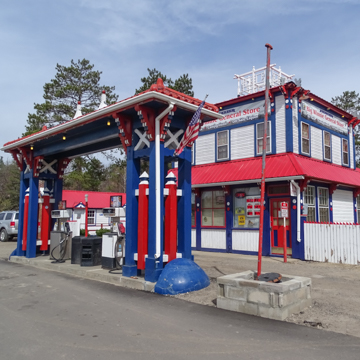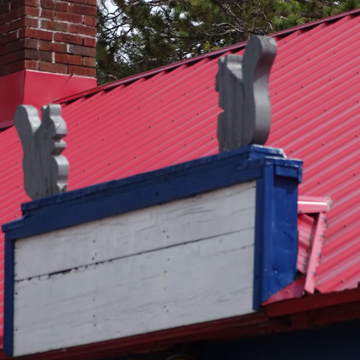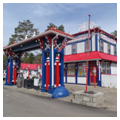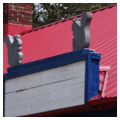You are here
Winnibigoshish Resort
The Big Winnie Resort and General Store complex, located in Bena at the south end of Lake Winnibigoshish, is a well-preserved example of the roadside attractions built across the United States during the first era of mass automobile transportation. In a time before widespread broadcast advertising, smart business owners realized that eye appeal was economically advantageous. Situated on U.S. Route 2, the major east-west arterial highway in northern Minnesota, Big Winnie reels in passing anglers and other travelers with bright patriotic colors, imaginative decorations, and quirky architecture.
Ernest Flemming was the first owner and operator of the Big Winnie Resort and General Store and had extensive land and business holdings in the Bena area. Begun in 1933, the complex eventually grew to forty acres and consisted of a main building, gas pump canopy, thirty rental cabins, and auxiliary buildings that included a pump house and fish-cleaning house. The original color scheme of the buildings was green with gray and red accents. However, when Standard Oil became the gasoline supplier, the buildings were repainted to match Standard Oil’s well-known red, white, and blue color scheme. Though the business is no longer associated with Standard Oil, that color palate has been retained.
The main building is a long, wood-frame rectangle measuring approximately 100 by 23 feet. It was originally decorated with wooden spires, zig-zag-shaped ornaments, and wooden gargoyles in the shapes of squirrels and owls. Few of these original ornamental elements survived; those that do survive have been used as templates to make replicas. The hipped roof of the main building was originally topped with a wood lattice in the form of a widow’s walk (inaccessible to the public) with a tall spire protruding from its center. The similarity between this spire and that of the R.W. Lindholm Service Station in Cloquet, Minnesota (1958), led some observers to speculate that the resort was designed by Frank Lloyd Wright. According to Flemming family lore, while Wright was vacationing in the area in the early 1930s he provided advice on the building’s design. However, there is no record of contact with Wright, nor do any other original drawings or building plans survive.
The ground floor of the main building originally contained a store, laundry facilities, bathrooms, and a dining hall that served both resort staff and customers. The second floor, which is only on the front portion of the building, originally contained the owners’ living quarters. Now the ground floor contains the store, bathrooms,
storage areas, and self-serve laundry facilities; the second floor has been converted to office space.
The establishment has never left the ownership of Flemming’s family. As of 2017, the complex is owned and operated by Flemming’s great-great grandson Arnold Dahl and his partner, Matthew Wooley, who acquired the property in 2004. There have been many changes to the property over the years as it has dwindled in size to fifteen acres. Part of the land was sold to the federal government and became a Civilian Conservation Corps camp. Surviving original structures include the main building, gas pump canopy, and just two of the original cabins. All of these structures suffered from neglect during the 1980s and have been greatly renovated by Dahl and Wooley.
The only original roofing material in the complex is on the gas pump canopy, which consists of metal “tiles” made to resemble clay tile roofing. Standing-seam steel roofing on the main building and the two cabins was installed in the twenty-first century. The two remaining cabins were the most upscale of the original thirty. They retain their original decorative brick chimneys and custom indoor wood mantels. The exterior wall surfaces of the cabins are mostly original wood siding with a unique wave profile. The cabin interiors have been extensively renovated.
References
Dahl, Arnold. Interview by Richard L. Kronick. April 27, 2016.
Frame, Robert, “Winnibigoshish Resort,” Cass County, Minnesota. National Register of Historic Places Inventory-Nomination Form, 1979. National Park Service, U.S. Department of the Interior, Washington D.C.
Sculle, Keith A. “Frank Redford’s Wigwam Village Chain: A Link in the Modernization of the American Roadside.” In Roadside America: The Automobile in Design and Culture, edited by Jan Jennings, 125–126. Ames,: Iowa State University Press, 1990.
Writing Credits
If SAH Archipedia has been useful to you, please consider supporting it.
SAH Archipedia tells the story of the United States through its buildings, landscapes, and cities. This freely available resource empowers the public with authoritative knowledge that deepens their understanding and appreciation of the built environment. But the Society of Architectural Historians, which created SAH Archipedia with University of Virginia Press, needs your support to maintain the high-caliber research, writing, photography, cartography, editing, design, and programming that make SAH Archipedia a trusted online resource available to all who value the history of place, heritage tourism, and learning.











